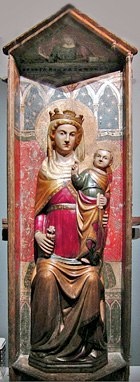
-
✴a polychrome figure of theMadonna and Child known as the Madonna di Fossa (illustrated here), enthroned in a tabernacle; and
-
✴the two painted panels that originally enclosed this tabernacle, each of which depicted four scenes from the life of Christ.
The panels were stolen and apparently dismembered in 1979. Part of the left panel, which depicts the Presentation at the Temple, has been recovered. This panel and the Madonna di Fossa are now in the Museo Nazionale d' Abruzzo.
This artist was also active in the Duchy of Spoleto in the decades before the Black Death (1348). In addition to the works below, a double-sided processional cross known as the Croce di Posta, which came from San Francesco a Posta and which is now the Museo Civico di Rieti, is attributed to him.
Spoleto
St Michael (14th century)
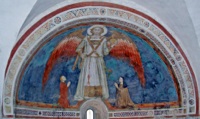
This fresco in the lunette of the right apsidal chapel in the crypt of San Ponziano is attributed to the Maestro di Fossa. It depicts the standing St Michael holding a sword and scales. A man dressed in red kneels to the left and a nun kneels to the right.
Madonna and Child (14th century)
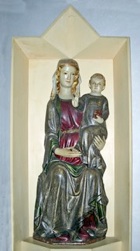
Silvestro Nessi (referenced below) has suggested that it came from Santa Maria di Turrita, Montefalco. A very similar statue was documented there in 1726, at which time it was “restored”. The effects of a poor restoration were removed from the statue in Spoleto in 1991-2. (The painted panels that probably closed the niche in which the statue in Santa Maria di Turrita was kept were certainly moved to the Duomo, Spoleto in 1837. They were subsequently returned to Montefalco and are now in the Pinacoteca there).
St Peter Martyr (14th century)
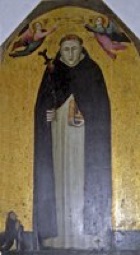
St Peter is shown against a gold background with a dagger in his shoulder while two angels hold a crown of martyrdom above his head. A small figure in the Dominican habit kneels to the right.
Madonna del latte (14th century)
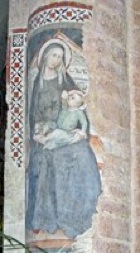
Madonna and Child with (14th century)
This fresco of the Madonna and Child with SS Michael, Laurence and a kneeling donor, which is attributed to the Maestro di Fossa, is in the old chancellery of Palazzo Vescovile.
Crucifixion (14th century)
Guide books to the closed church of San Maria della Misericordia describe a fresco of the Crucifixion that is attributed to the Maestro di Fossa.
Rome (ex-Montefalco)
Polyptych (14th century)
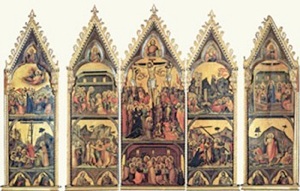
This polyptych was documented in 1771 in the right aisle of San Francesco, Montefalco, by which time it had already been cut into three parts. It seems likely that it had originally formed the dossal of the high altar of the church, and that it had been removed in 1562, when the choir screen had been demolished. Its components were documented again at the time of the French invasion of 1798.
The panels were subsequently unrecorded until 1973, when Roberto Longhi published details of a dossal in the Pinacoteca Vaticana that he attributed to the Maestro di Fossa. Silvestro Nessi (referenced below) recognised that the panels matched the 1771 description. They are now in the Vatican Palace.
The panels depict (from the top left to bottom right)
-
✴First panel:
-
•St Luke;
-
•Ascension of Christ;
-
•Lamentation;
-
•SS Paul and Francis;
-
✴Second panel:
-
•St Matthew;
-
•Christ washing the feet of the Disciples;
-
•Capture of Christ;
-
•SS Catherine of Alexandria and Nicholas of Bari;
-
✴Central panel:
-
•Christ the Redeemer;
-
•Crucifixion, with St Francis at the foot of the cross;
-
•Last Supper;
-
✴Fourth panel:
-
•St John;
-
•Christ in the Garden of Gethsemane;
-
•Road to Calvary;
-
•SS Peter and John the Evangelist;
-
✴Fifth panel:
-
•St Mark;
-
•Pentecost;
-
•Resurrection;
-
•SSLouis of Toulouse and Clare.
Read more:
The theory about the origin of the statue of the Madonna and Child in the Duomo that is summarised above comes from:
S. Nessi, “La Chiesa di Santa Maria di Turrita”, (1999) Montefalco
The identification of the provenance of the polyptych that is now in Rome is made in:
S. Nessi, “Dipinti Provenienti da Montefalco Conservati in Vaticano”, Bollettino dei Musei e Gallerie Pontificie, 11 (1991) 101-7
Return to the page on Art in: Montefalco Spoleto.



